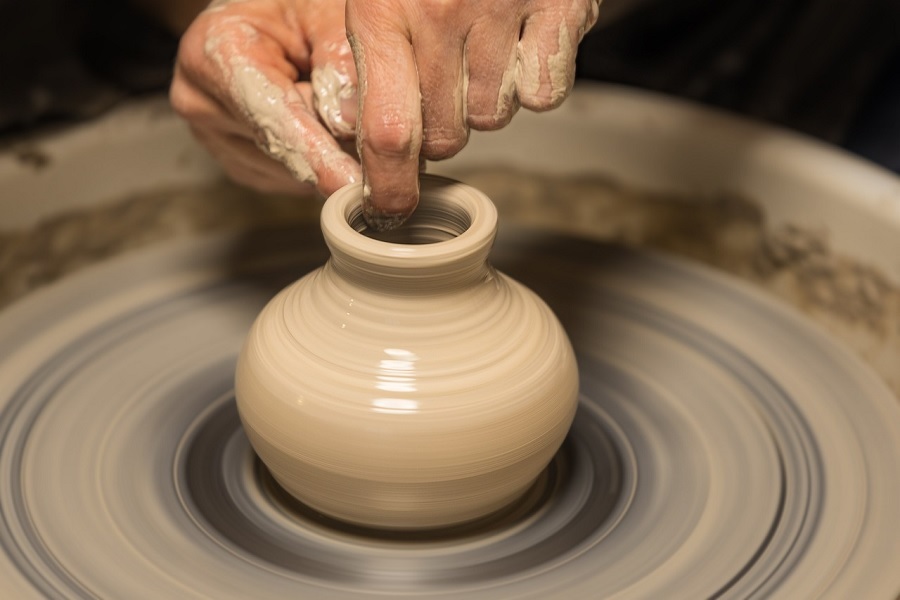The Art of Clay : Discovering the Timeless Beauty of Pottery Crafts

Pottery is one of the most ancient and universal art forms, transcending cultures and centuries to become a symbol of both creativity and functionality. From the simple bowl to intricately designed vases, pottery reflects the unique story of the places and people who create it. The craft of pottery involves not just the shaping of clay, but also the weaving of culture, history, and tradition into every piece. Whether you’re a collector, a creator, or simply someone who appreciates fine craftsmanship, pottery offers a deep connection to the past and the artistry of the present.
A Journey Through the Clay: The History of Pottery
Pottery is thought to be over 20,000 years old, with the earliest known examples originating from the Neolithic period. Early pottery was primarily functional, used for storing food, water, and other essential goods. Over time, however, it evolved into a form of art, with cultures around the world developing their own unique styles and techniques.
From the terracotta figures of ancient China to the delicate blue-and-white ceramics of Delft in the Netherlands, pottery has provided a window into the past, telling the stories of the civilizations that made it. The craft’s adaptability allowed it to endure, evolving through different periods, styles, and influences while always maintaining its cultural significance.
The Process of Creating Pottery: From Clay to Craftsmanship
Creating pottery is an intricate, multi-step process that requires skill, patience, and an artistic eye. While the methods may vary slightly depending on tradition and region, the general process remains the same.
Selecting and Preparing Clay: The first step in pottery making is choosing the right type of clay. Pottery clay is sourced from natural materials like dirt and minerals. Once collected, the clay is kneaded to remove air bubbles and ensure it is pliable enough to shape.
Shaping: Pottery can be shaped by hand or on a potter’s wheel. Potters use various tools, including their hands, wooden paddles, and metal instruments, to mold the clay into the desired form. This stage is where the creativity of the artisan shines through, as the clay is transformed into bowls, mugs, vases, or more complex sculptural works.
Drying: After shaping, the pottery must dry to a leather-hard state before it is fired. This stage allows the piece to harden and become sturdy enough to handle the firing process.
Firing: Firing is the process of baking the clay in a kiln at extremely high temperatures, which transforms the raw clay into a durable, permanent form. The first firing is called "bisque firing," which makes the pottery hard enough to be glazed. The glaze is often applied after the first firing.
Glazing: Glaze is applied to pottery for both decorati
Final Firing: After glazing, pottery is fired again in the kiln to set the glaze and complete the process. This final firing can give the pottery its distinctive color and texture, ranging from deep, rich blues to earth-toned terracotta hues.
Different Pottery Styles Around the World
The beauty of pottery lies not just in its utility, but in the distinctive styles that vary from culture to culture. These styles represent the values, aesthetics, and techniques passed down through generations, each with its own unique signature.
Japanese Pottery: Known for its refined elegance, Japanese pottery often emphasizes simplicity, natural forms, and a deep connection to the natural world. Styles such as Raku, Kutani, and Arita have long been revered for their aesthetic qualities and careful craftsmanship.
Mexican Pottery: Vibrant and colorful, Mexican pottery often features bold designs, intricate patterns, and symbolic motifs. The Talavera pottery from Puebla is particularly famous for its beautiful hand-painted designs and ceramic tiles.
Greek Pottery: Ancient Greek pottery is iconic, especially the black-figure and red-figure styles. These pots were used for both practical and ceremonial purposes and often depicted mythological scenes or daily life.
Native American Pottery: Indigenous cultures of North America, particularly the Pueblo people of the Southwest, are known for their distinct pottery styles. The use of geometric patterns and symbolic designs, often reflecting the natural world and spiritual beliefs, makes Native American pottery unique.
Turkish Pottery: Turkish pottery, especially from the region of ?znik, is renowned for its bold colors, floral patterns, and intricate designs. It has a rich tradition of producing tiles and decorative ceramics for mosques and other important buildings.
Chinese Pottery: Chinese pottery is known for its refinement and technological advancement. From the iconic porcelain of the Tang Dynasty to the colorful ceramics of the Ming Dynasty, Chinese pottery represents a long and distinguished history of innovation and artistry.
Pottery as Cultural Heritage and Art
Beyond its beauty, pottery serves as a powerful cultural marker. The methods, materials, and designs of pottery can tell us a great deal about the values and practices of the cultures that created them. Each region has developed its own style of pottery, shaped by geography, climate, and the people’s way of life.
The craft of pottery is also an important aspect of cultural preservation. In many parts of the world, traditional pottery-making techniques are passed down through generations, keeping ancient knowledge alive. This has led to a growing interest in preserving traditional pottery crafts, as they represent more than just art—they are a tangible link to the past and the cultural identity of a community.
The Modern Revival of Pottery Crafts
In today’s fast-paced, mass-produced world, the demand for handmade, artisanal goods is on the rise. Pottery, with its rich history and unique craftsmanship, has experienced a resurgence in popularity. Many contemporary artists are reviving ancient techniques and putting their own modern twist on pottery, blending tradition with innovation.
Pottery enthusiasts and collectors often seek out handmade pieces for their authenticity, craftsmanship, and connection to the artist. Pottery, whether functional or decorative, has become highly prized in the art world, and artisanal pottery workshops are thriving in many regions.



















